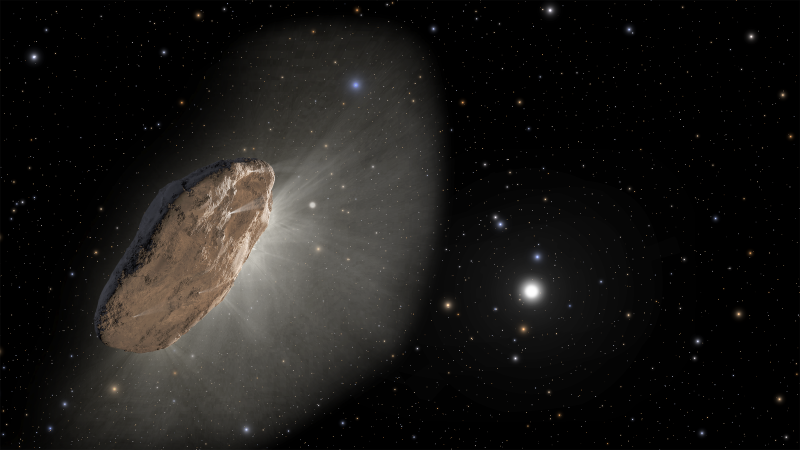
In 2017, an object later named ‘Oumuamua became known as the first observed interstellar visitor to our solar system. This oblong space rock moved in ways that didn’t fit with what scientists understand about comets or asteroids. Its strange acceleration led to many theories as to what ‘Oumuamua might be, including the idea that it might be an alien spacecraft. On March 22, 2023, researchers at the University of California-Berkeley and Cornell University said they’ve now got a simpler explanation for ‘Oumuamua and its odd behavior. They said it’s a comet from another solar system that warmed enough when it passed our sun to get a push from the outgassing of hydrogen.
Jennifer Bergner of the University of California-Berkeley and Darryl Seligman at Cornell University authored a peer-reviewed study, which they published in the journal Nature on March 22, 2023.
‘Oumuamua a comet? Avi Loeb responds
Last chance to get a moon phase calendar! Only a few left. On sale now.
The strange case of ‘Oumuamua
‘Oumuamua was the source of astronomers’ musings for two reasons: It’s the first-known interstellar visitor, and it’s strange. It wasn’t obviously either a comet or asteroid. And it didn’t move as scientists expected.
Plus, while ‘Oumuamua was the first-known interstellar visitor, it’s no longer the only known one. In 2019, astronomers discovered 2I/Borisov, a comet from another solar system that flew past our sun. Borisov looked and acted more like a traditional comet. It had a coma and a tail.
Then, analysis of a meteor that hit Earth in 2014 showed that it, too, was a visitor from another solar system. Avi Loeb and his group at Harvard – The Galileo Project – plan to search for this meteor under the Pacific Ocean in the summer of 2023.
‘Oumuamua defied classification because of its physical features and motion. It’s shape was somewhere between a pancake and a cigar; it had no coma or tail and was smaller than traditional comets.
Still, what defied standard explanations was the way ‘Oumuamua accelerated away from the sun. Many theories have tried to explain this acceleration. And the researchers at UC-Berkeley and Cornell claim that their newest theory does the cleanest job.
Acceleration from outgassing
The researchers said the reason ‘Oumuamua experienced a push from the outgassing is because of its small size. All the comets we know of in our solar system have been 0.5 mile to hundreds of miles (1 kilometer to hundreds of kilometers) across, whereas ‘Oumuamua is around 377 feet (115 meters) at its widest. Bergner said:
For a comet several kilometers across, the outgassing would be from a really thin shell relative to the bulk of the object, so both compositionally and in terms of any acceleration, you wouldn’t necessarily expect that to be a detectable effect. But because ‘Oumuamua was so small, we think that it actually produced sufficient force to power this acceleration.

The source of the outgassing
When astronomers observed ‘Oumuamua in 2017, they couldn’t see a coma, outgassed molecules or dust. Plus, their calculations of solar energy on the object couldn’t provide the kick they observed. With the amount of solar energy ‘Oumuamua was getting, the only thing that could provide enough of a non-gravitational kick to match the observed acceleration was a hypervolatile gas. For example, hydrogen (H2). Seligman said:
We had never seen a comet in the solar system that didn’t have a dust coma. So, the non-gravitational acceleration really was weird.
So, if ‘Oumuamua was a comet (even without a visible coma or tail) from interstellar space, is it possible it had a store of hydrogen to outgas and provide the kick that occurred near our sun? Bergner explained:
A comet traveling through the interstellar medium basically is getting cooked by cosmic radiation, forming hydrogen as a result. Our thought was: If this was happening, could you actually trap it in the body, so that when it entered the solar system and it was warmed up, it would outgas that hydrogen? Could that quantitatively produce the force that you need to explain the non-gravitational acceleration?
Avi Loeb responds
Harvard astronomer Avi Loeb has been the most vocal scientist in putting forward theories that ‘Oumuamua is alien technology. In media reports from various places, he was quick to point out this week that the new paper is not the final word. For example, he told the New York Times on March 22, 2023:
The authors of the new paper claim that it was a water ice comet even though we did not see the cometary tail. This is like saying an elephant is a zebra without stripes.
And Loeb wrote in an essay in Medium on March 22:
Altogether, it is fantastic to see the continuing interest within the mainstream of astronomy to explain the anomalous acceleration of `Oumuamua, more than 5 years after its discovery.
It is good to have alternative models at hand as we search for the next ‘Oumuamua with the forthcoming Legacy Survey of Space and Time (LSST) on the Vera C. Rubin Observatory.
Avi Loeb sent EarthSky a lengthy rebuttal to the new paper, which you can read here.
Old research led the way
Bergner discovered old research dating back to the 1970s that provided the answer. She found studies that said when ice is hit by high-energy particles, such as cosmic rays in interstellar space, it produces an abundance of molecular hydrogen (H2) trapped in the ice. In fact, these cosmic rays are capable of penetrating tens of meters into ice. That means the cosmic rays could convert more than 1/4 of the comet’s water to hydrogen gas.
Past experiments showed that when the sun warms the ice, it changes from an amorphous structure to a crystal structure. This forces bubbles of hydrogen gas out. The gas, ejected in either a beam or fan-shaped spray, would be an ample amount to provide the observed change in ‘Oumuamua’s orbit. Bergner said:
The main takeaway is that ‘Oumuamua is consistent with being a standard interstellar comet that just experienced heavy processing. The models we ran are consistent with what we see in the solar system from comets and asteroids. So, you could essentially start with something that looks like a comet and have this scenario work.
What about ‘Oumuamua’s lack of a coma and tail? Seligman explained:
Even if there was dust in the ice matrix, you’re not sublimating the ice, you’re just rearranging the ice and then letting H2 get released. So, the dust isn’t even going to come out.

Seligman continued:
What’s beautiful about Jenny’s idea is that it’s exactly what should happen to interstellar comets. We had all these stupid ideas, like hydrogen icebergs and other crazy things, and it’s just the most generic explanation.
Chasing down ‘Oumuamua
Seligman was one of the first to suggest that it would be possible to chase down ‘Oumuamua for study. A team called Project Lyra is currently studying the feasibility of launching a spacecraft as early as 2028 to reach ‘Oumuamua by 2047.
EarthSky spoke to Seligman and discussed the idea of exploring ‘Oumuamua or the next interstellar object that comes along. Seligman told EarthSky:
It’s a really exciting thing. We should be finding enough of them that will come close enough to Earth to do a space-based rendezvous.
He said that one neat thing about these objects that come from interstellar space is that they have such high velocities that we wouldn’t need to match orbits with it and crash into it. We’d just have to position a spacecraft or probe in front of it. As Seligman said:
It’s like jumping in front of a speeding car.
Seligman said that one of the things they’d look for is how representative these objects are of interstellar objects. For example, Borisov, which is considered the “more normal” interstellar object, is really not all that similar to comets in our solar system. The chemical composition of Borisov contains much more hypervolatiles than most solar system comets.
Seligman also said that if we could sample the material of an interstellar object or have a probe impact one, it would release the internal material. Inside the object the material is more pristine and less processed, giving us a better idea of the composition of the objects when they were formed in their distant solar systems. We could spectroscopically analyze the material from telescopes on the ground. (Read more about the DART mission that impacted an asteroid.)
Is this the last word on ‘Oumuamua?
Since ‘Oumuamua’s discovery in 2017, scientists have since discovered six other comets without a coma but with similar accelerations. Scientist call these objects dark comets and believe they are common. They don’t believe hydrogen is the responsible source of acceleration in these solar system objects, but their existence teaches us more about these strange types of objects.
One of these dark comets, 1998 KY26, will soon be receiving a visit from Japan’s Hayabusa2 mission. In 2018, the spacecraft explored the asteroid Ryugu.
Seligman talked about how all the pieces are coming together:
Jenny’s definitely right about the entrapped hydrogen. Nobody had thought of that before. Between discovering other dark comets in the solar system and Jenny’s awesome idea, I think it’s got to be correct. Water is the most abundant component of comets in the solar system and likely in extrasolar systems, as well. And if you put a water-rich comet in the Oort cloud or eject it into the interstellar medium, you should get amorphous ice with pockets of H2.
Future observations and mysteries
Upcoming instruments such as those at the Vera C. Rubin Observatory, slated for operation in 2025, should find more of these objects. The team projects that the Rubin Observatory could detect from one and three interstellar comets like ‘Oumuamua per year, and even more interstellar comets that resemble Borisov.
These interstellar visitors can help us learn even more about solar systems beyond our own. As gravitational interactions eject comets from other suns and send them speeding toward our own, we can get a glimpse of what distant worlds might look like. As Seligman said:
The comets and asteroids in the solar system have arguably taught us more about planet formation than what we’ve learned from the actual planets in the solar system. I think that the interstellar comets could arguably tell us more about extrasolar planets than the extrasolar planets we are trying to get measurements of today.
Seligman also said he’s amazed by the long road it’s taken to come to the solution for ‘Oumuamua’s strange behavior. He said he’s awed by how understanding this interstellar visitor will help us learn more about objects such as dark comets in our own solar system. He said:
This thing was only observable for about two weeks. But it was one of the most scrutinized objects in that period of time. It took five years, going through wild theories, until we got to this idea that is the simplest that actually explains it. It also explains objects in the solar system that we didn’t understand before.
Is it the final word? Time will tell …
Bottom line: Researchers say they have solved the mystery of ‘Oumuamua’s strange orbit. Outgassing from hydrogen inside the interstellar comet may have given the object the telltale push.
Source: Acceleration of 1I/‘Oumuamua from radiolytically produced H2 in H2O ice











